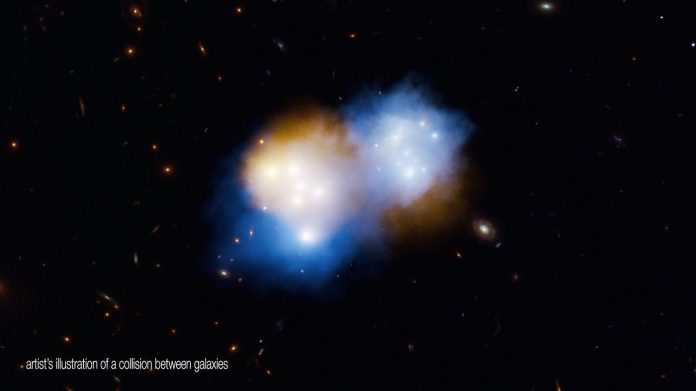
Dark matter is a mysterious and captivating subject.
It’s a strange concept and we don’t really have a handle on what it actually is.
One of the strongest pieces of evidence that dark matter is a particle comes from cosmic collisions.
These collisions chiefly occur when clusters of galaxies interact such as the famous Bullet Cluster.
Gravitational lensing reveals how the dark matter component couples from gas and dust in the cluster but now, astronomers have found another galaxy cluster collision but it is different, showing the collision from a new angle.
Dark matter was first talked about in the 1930’s by Swiss astronomer Fritz Zwicky who observed the Coma Cluster.
The observations found that the galaxies in the cluster were travelling faster than could be explained by visible mass alone.
Zwicky proposed the existence of an unseen type of material, known as dark matter which was gravitationally effecting the galaxies. In the 1970s’s even more evidence emerged when spiral galaxy observations found the other regions rotated at the same speed as the inner regions.
Again, it suggested some otherwise unseen matter which surrounded the stars in the galaxies. Even so, dark matter has not yet been directly observed, largely due to its complete lack of interaction with normal matter.
Galaxy clusters are one phenomenon where dark matter seems to have a significant impact. The component galaxies are bound together under the force of gravity.
When we explore galaxy clusters and the amount of matter that seems to be present, only about 15% is from normal matter. In the case of galaxies, this s mostly in the state of hot gas but the rest will be made up of stars, planets and even people! The remaining 85% must be therefore, dark matter.
Recent observations of the collision of clusters collectively known as MACS J0018.5+1626 show that the individual galaxies are largely unscathed. In galaxy clusters the distance between the galaxies are vast however the gas components have become turbulent and superheated.
Typically such events would be revealed through gravitational and electromagnetic effects from normal matter but dark matter just interacts through gravity.
The Submilimeter Observatory from Caltech, the Keck Observatory on Mauna Kea, Chandra X-Ray Observatory, Hubble Space Telescope, Herschel Space Observatory and Planck Observatory were all part of the project which have been observing the collision of MACS J0018.5+1626. The disassociation or decoupling of dark matter and normal matter in such collisions has a been seen before in the Bullet Cluster.
In this event the hot gas and normal matter was lagging behind dark matter as the clusters passed through each other. MACS J0018.5+1626 is the same and with similar lagging between normal and dark matter. MACS J0018.5+1626 however has a slightly different orientation and offers a unique view on this type of event.
To try to understand the process, a team of researchers used a method known as the Kinetic-Sunyaev-Zel’dovich effect (the spectral distortion of the cosmic microwave background through inverse Compton scattering.)
This is not the first time the effect has been observed though, a team of astronomers detected it in a cluster known as MACS J0717. Multiple observations have since been made of the effect allowing astronomers to measure the speed of gas and normal matter. Measuring the speed of galaxies allowed for the deduction of the speed of the dark matter too.
It is hoped that future studies will reveal even more clues about the nature of dark matter. The observations of MACS J0018.5+1626 and previously the Bullet cluster have given a good starting point but more detailed steeds are required.
Written by Mark Thompson/Universe Today.



